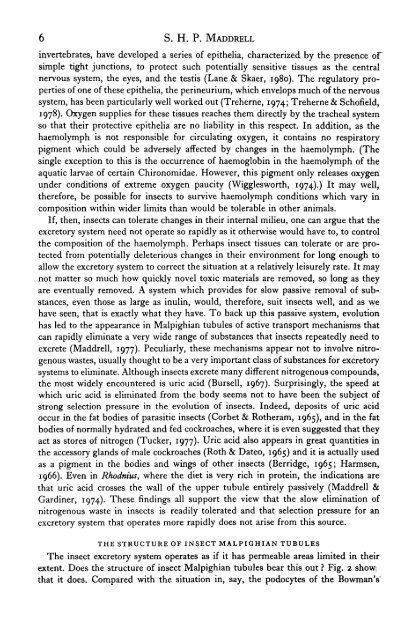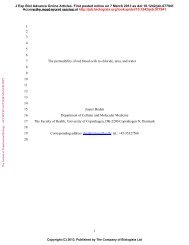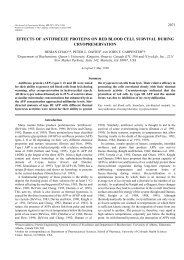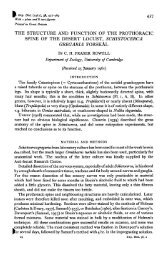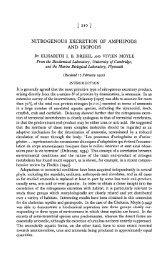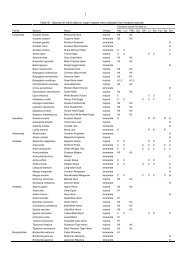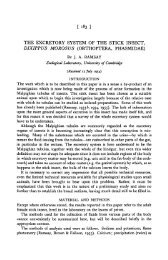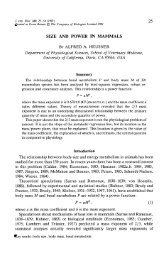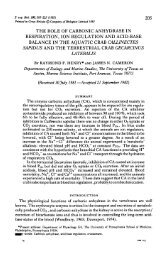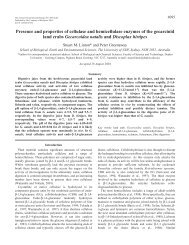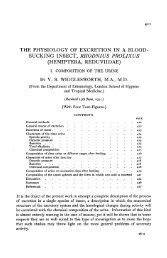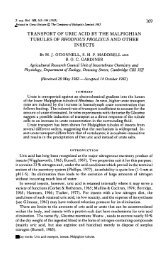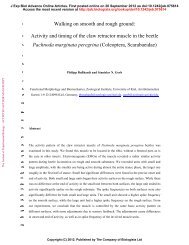the functional design of the insect excretory system - The Journal of ...
the functional design of the insect excretory system - The Journal of ...
the functional design of the insect excretory system - The Journal of ...
You also want an ePaper? Increase the reach of your titles
YUMPU automatically turns print PDFs into web optimized ePapers that Google loves.
6 S. H. P. MADDRELL<br />
invertebrates, have developed a series <strong>of</strong> epi<strong>the</strong>lia, characterized by <strong>the</strong> presence oF<br />
simple tight junctions, to protect such potentially sensitive tissues as <strong>the</strong> central<br />
nervous <strong>system</strong>, <strong>the</strong> eyes, and <strong>the</strong> testis (Lane & Skaer, 1980). <strong>The</strong> regulatory properties<br />
<strong>of</strong> one <strong>of</strong> <strong>the</strong>se epi<strong>the</strong>lia, <strong>the</strong> perineurium, which envelops much <strong>of</strong> <strong>the</strong> nervous<br />
<strong>system</strong>, has been particularly well worked out (Treherne, 1974; Treherne & Sch<strong>of</strong>ield,<br />
1978). Oxygen supplies for <strong>the</strong>se tissues reaches <strong>the</strong>m directly by <strong>the</strong> tracheal <strong>system</strong><br />
so that <strong>the</strong>ir protective epi<strong>the</strong>lia are no liability in this respect. In addition, as <strong>the</strong><br />
haemolymph is not responsible for circulating oxygen, it contains no respiratory<br />
pigment which could be adversely affected by changes in <strong>the</strong> haemolymph. (<strong>The</strong><br />
single exception to this is <strong>the</strong> occurrence <strong>of</strong> haemoglobin in <strong>the</strong> haemolymph <strong>of</strong> <strong>the</strong><br />
aquatic larvae <strong>of</strong> certain Chironomidae. However, this pigment only releases oxygen<br />
under conditions <strong>of</strong> extreme oxygen paucity (Wigglesworth, 1974).) It may well,<br />
<strong>the</strong>refore, be possible for <strong>insect</strong>s to survive haemolymph conditions which vary in<br />
composition within wider limits than would be tolerable in o<strong>the</strong>r animals.<br />
If, <strong>the</strong>n, <strong>insect</strong>s can tolerate changes in <strong>the</strong>ir internal milieu, one can argue that <strong>the</strong><br />
<strong>excretory</strong> <strong>system</strong> need not operate so rapidly as it o<strong>the</strong>rwise would have to, to control<br />
<strong>the</strong> composition <strong>of</strong> <strong>the</strong> haemolymph. Perhaps <strong>insect</strong> tissues can tolerate or are protected<br />
from potentially deleterious changes in <strong>the</strong>ir environment for long enough to<br />
allow <strong>the</strong> <strong>excretory</strong> <strong>system</strong> to correct <strong>the</strong> situation at a relatively leisurely rate. It may<br />
not matter so much how quickly novel toxic materials are removed, so long as <strong>the</strong>y<br />
are eventually removed. A <strong>system</strong> which provides for slow passive removal <strong>of</strong> substances,<br />
even those as large as inulin, would, <strong>the</strong>refore, suit <strong>insect</strong>s well, and as we<br />
have seen, that is exactly what <strong>the</strong>y have. To back up this passive <strong>system</strong>, evolution<br />
has led to <strong>the</strong> appearance in Malpighian tubules <strong>of</strong> active transport mechanisms that<br />
can rapidly eliminate a very wide range <strong>of</strong> substances that <strong>insect</strong>s repeatedly need to<br />
excrete (Maddrell, 1977). Peculiarly, <strong>the</strong>se mechanisms appear not to involve nitrogenous<br />
wastes, usually thought to be a very important class <strong>of</strong> substances for <strong>excretory</strong><br />
<strong>system</strong>s to eliminate. Although <strong>insect</strong>s excrete many different nitrogenous compounds,<br />
<strong>the</strong> most widely encountered is uric acid (Bursell, 1967). Surprisingly, <strong>the</strong> speed at<br />
which uric acid is eliminated from <strong>the</strong> body seems not to have been <strong>the</strong> subject <strong>of</strong><br />
strong selection pressure in <strong>the</strong> evolution <strong>of</strong> <strong>insect</strong>s. Indeed, deposits <strong>of</strong> uric acid<br />
occur in <strong>the</strong> fat bodies <strong>of</strong> parasitic <strong>insect</strong>s (Corbet & Ro<strong>the</strong>ram, 1965), and in <strong>the</strong> fat<br />
bodies <strong>of</strong> normally hydrated and fed cockroaches, where it is even suggested that <strong>the</strong>y<br />
act as stores <strong>of</strong> nitrogen (Tucker, 1977). Uric acid also appears in great quantities in<br />
<strong>the</strong> accessory glands <strong>of</strong> male cockroaches (Roth & Dateo, 1965) and it is actually used<br />
as a pigment in <strong>the</strong> bodies and wings <strong>of</strong> o<strong>the</strong>r <strong>insect</strong>s (Berridge, 1965; Harmsen,<br />
1966). Even in Rhodnius, where <strong>the</strong> diet is very rich in protein, <strong>the</strong> indications are<br />
that uric acid crosses <strong>the</strong> wall <strong>of</strong> <strong>the</strong> upper tubule entirely passively (Maddrell &<br />
Gardiner, 1974). <strong>The</strong>se findings all support <strong>the</strong> view that <strong>the</strong> slow elimination <strong>of</strong><br />
nitrogenous waste in <strong>insect</strong>s is readily tolerated and that selection pressure for an<br />
<strong>excretory</strong> <strong>system</strong> that operates more rapidly does not arise from this source.<br />
THE STRUCTURE OF INSECT MALPIGHIAN TUBULES<br />
<strong>The</strong> <strong>insect</strong> <strong>excretory</strong> <strong>system</strong> operates as if it has permeable areas limited in <strong>the</strong>ir<br />
extent. Does <strong>the</strong> structure <strong>of</strong> <strong>insect</strong> Malpighian tubules bear this out ? Fig. 2 showi<br />
that it does. Compared with <strong>the</strong> situation in, say, <strong>the</strong> podocytes <strong>of</strong> <strong>the</strong> Bowman's


